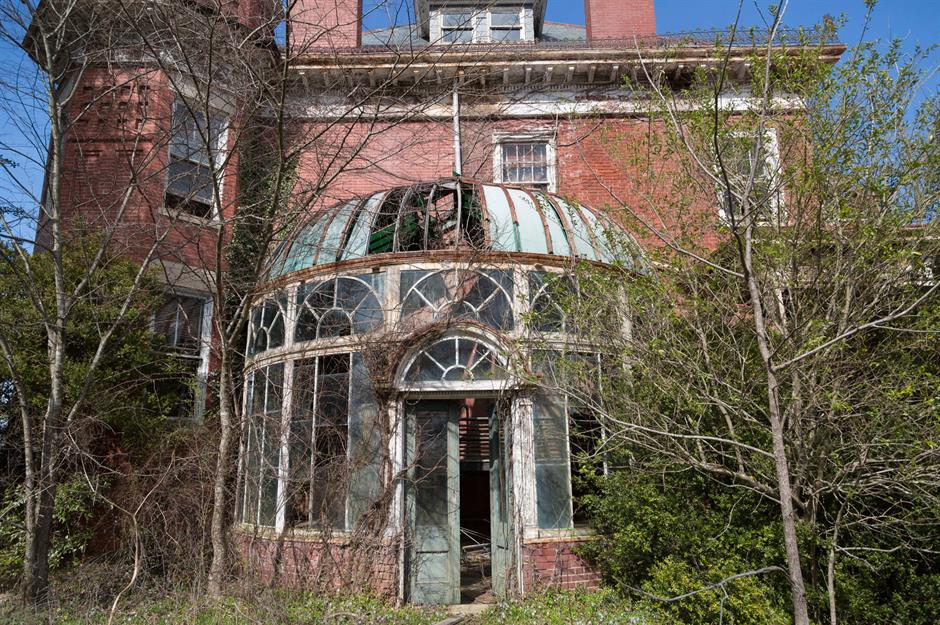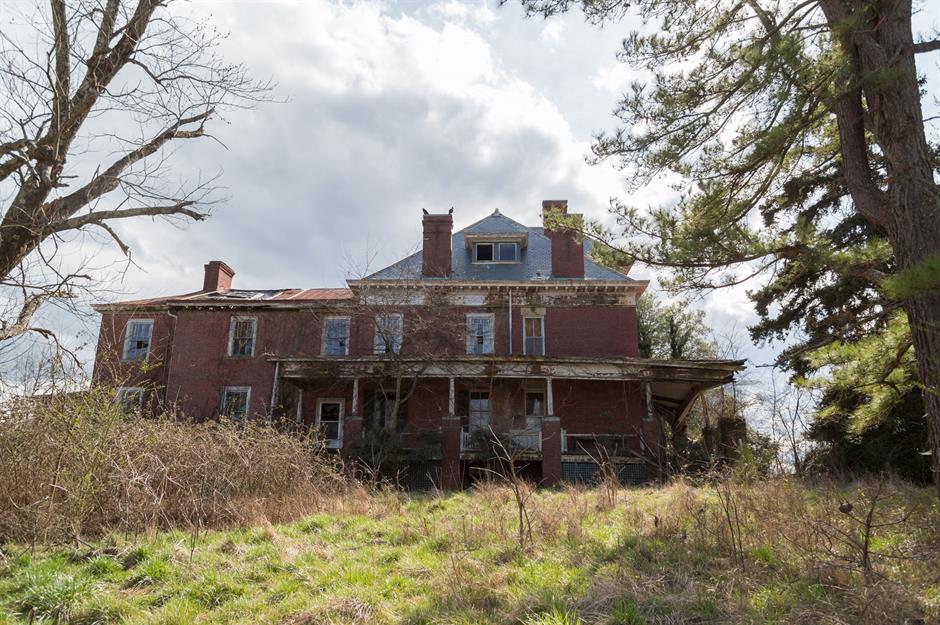Discover this deserted mansion in the middle of a golf course in Virginia
Idly sulking in the centre of a golf course lies the once-magnificent Dunnington Mansion, also known as Poplar Hill, near Farmville, Virginia. This historic home, now in a sorry state, captivates our attention as we delve into its intriguing story. Join us as we embark on a journey to explore the faded grandeur of this remarkable mansion within the Manor Resort Golf Club.
The imposing red-brick manor, adorned with architectural brickwork, is an unexpected sight amidst the Manor Resort Golf Club’s impeccably landscaped fairways and serene surroundings. The stark contrast between the dilapidated mansion and the beautifully manicured golf course piques our curiosity.
#1

Image Credit: Bryan Sansivero
#2

Image Credit: Bryan Sansivero
#3

Image Credit: Bryan Sansivero
#4

Geni / James Hutchison [Public domain]
#5

Image Credit: Bryan Sansivero
Approaching the mansion, discarded debris, such as rotting wood planks and a pressurized barrel, reveals the neglect in this once-grand estate. Vines engulf the surrounding land, obscuring any trace of a pathway leading to the front porch. However, despite the passage of time, the mansion’s exterior remains relatively intact, with its turret and architectural brickwork standing as testaments to its former glory.
The story of the Dunnington Mansion traces back to the 1700s when Richard Woodson established the Poplar Hill Plantation on the vast estate in Prince Edward County. What began as a modest four-room house expanded under the ownership of Agnes and Francis Watkins in the late 18th century. The plantation was once home to quarters for enslaved African-Americans, though these structures no longer remain.
Frances and James Wood, the daughter and son-in-law of Agnes and Francis Watkins, further expanded the mansion, giving rise to its reputation as the Wood Plantation house. 1860 Captain John Knight acquired the property, passing it down to his daughter India and her husband, Walter Grey Dunnington, a prominent tobacco tycoon. Walter Dunnington embarked on an extensive renovation project in 1897, completely transforming the mansion and expanding its size to encompass 14 rooms.
#6

Image Credit: Bryan Sansivero
#7

Image Credit: Bryan Sansivero
#8

Image Credit: Bryan Sansivero
#9

Image Credit: Bryan Sansivero
#10

Image Credit: Bryan Sansivero
#11

Image Credit: Bryan Sansivero
As we step into the mansion, we are greeted by an extravagant entrance foyer with its vast brick fireplace, vaulted ceiling, and exquisite wood panelling. The space exudes an air of luxury, despite the peeling wallpaper and dusty floors that witness the passage of time. Walter Dunnington spared no expense in his renovation efforts, adorning the interiors with the finest Romanesque Revival aesthetics and state-of-the-art amenities. The mansion quickly became a gathering place for Farmville’s high society, hosting illustrious guests in its sumptuous parlours and regal formal dining room.
Among the mansion’s fascinating features are the turret alcoves, boasting expansive bay windows that likely served as tranquil sitting areas or cosy reading nooks. The estate also encompasses an adjunct parlour positioned towards the rear of the house, offering a more relaxed and informal atmosphere. The highlight of this space is undoubtedly the floor-to-ceiling French doors, flooding the room with natural light and offering enchanting views of the surroundings.
#12

Image Credit: Bryan Sansivero
#13

Image Credit: Bryan Sansivero
#14

Image Credit: Bryan Sansivero
#15

Image Credit: Bryan Sansivero
#16

Image Credit: Bryan Sansivero
Walter Grey Dunnington’s prosperity extended beyond his grand mansion. His involvement in the tobacco business and banking allowed him to become one of the largest tobacco dealers in the area, supplying countries as far away as Italy. Despite facing setbacks, such as the destruction of his Dunnington factory building by fire in 1898, Walter Dunnington persevered, and a new tobacco plant was swiftly constructed in Farmville. After his passing in 1922, his wife India continued to reside in the mansion until she died in 1960 at the impressive age of 103.
#17

Image Credit: Bryan Sansivero
#18

Image Credit: Bryan Sansivero
#19

Image Credit: Bryan Sansivero
#20

Image Credit: Bryan Sansivero
#21

Image Credit: Bryan Sansivero
The Dunnington Mansion served as a testament to both wealth and generosity. India Dunnington, known for her kindness, would bake cookies for the plantation workers’ children and allowed them to play hide-and-seek within the mansion’s labyrinthine corridors. It must have been a truly enchanting place for the Dunnington children to grow up. Today, the estate is a faded reminder of its illustrious past, waiting for its story to be rediscovered and retold.
The property has faced challenges in recent years, and restoration plans have been put on hold due to funding issues. 2020 the Dunnington Mansion was auctioned, awaiting new custodians who may breathe life into its faded grandeur.
#22

Image Credit: Bryan Sansivero
#23

Image Credit: Bryan Sansivero
#24

Image Credit: Bryan Sansivero
#25

Image Credit: Bryan Sansivero
#26

Image Credit: Bryan Sansivero
As we bid farewell to the once-magnificent Dunnington Mansion, we leave with a sense of awe for its history and hope that its future may yet bring about a renaissance, ensuring the preservation of this architectural gem for generations to come.
Image: Bryan Sansivero, st.severus
Via: [loveproperty]








